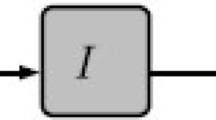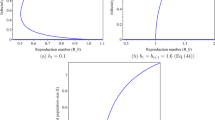Abstract
Over the past several decades, there has been a proliferation of epidemiological models with ordinary derivatives replaced by fractional derivatives in an ad hoc manner. These models may be mathematically interesting, but their relevance is uncertain. Here we develop an SIR model for an epidemic, including vital dynamics, from an underlying stochastic process. We show how fractional differential operators arise naturally in these models whenever the recovery time from the disease is power-law distributed. This can provide a model for a chronic disease process where individuals who are infected for a long time are unlikely to recover. The fractional order recovery model is shown to be consistent with the Kermack–McKendrick age-structured SIR model, and it reduces to the Hethcote–Tudor integral equation SIR model. The derivation from a stochastic process is extended to discrete time, providing a stable numerical method for solving the model equations. We have carried out simulations of the fractional order recovery model showing convergence to equilibrium states. The number of infecteds in the endemic equilibrium state increases as the fractional order of the derivative tends to zero.



Similar content being viewed by others
References
Andersson H, Britton T (2000) Stochastic epidemic models and their statistical analysis, vol 151. Springer, New York
Angstmann CN, Donnelly IC, Henry BI (2013a) CTRW with reactions, forcing and trapping. Math Model Nat Phenom 8(02):17–27
Angstmann CN, Donnelly IC, Henry BI (2013b) Pattern formation on networks with reactions: a continuous time random walk approach. Phys Rev E 87(3):032804
Angstmann CN, Donnelly IC, Henry BI, Nichols JA (2015) A discrete time random walk model for anomalous diffusion. J Comput Phys 293:53–69
Ansari SP, Agrawal SK, Das S (2015) Stability analysis of fractional-order generalized chaotic susceptible-infected-recovered epidemic model and its synchronization using active control method. Pramana 84(1):23–32
Arafa A, Rida S, Khalil M (2012) Solutions of fractional order model of childhood diseases with constant vaccination strategy. Math Sci Lett 1(1):17–23
Arqub OA, El-Ajou A (2013) Solution of the fractional epidemic model by homotopy analysis method. J King Saud Univ Sci 25(1):73–81
Barkai E, Metzler R, Klafter J (2000) From continuous time random walks to the fractional Fokker–Planck equation. Phys Rev E 61(1):132
Bateman H, Erdelyi A (1953) Higher transcendental functions (Volumes I-III). McGraw-Hill Book Company, New York
Demirci E, Unal A, Özalp N (2011) A fractional order SEIR model with density dependent death rate. Hacet J Math Stat 40(2):287–295
Diethelm K (2013) A fractional calculus based model for the simulation of an outbreak of dengue fever. Nonlinear Dyn 71(4):613–619
Diethelm K, Ford N, Freed A (2002) A predictor-corrector approach for the numerical solution of fractional differential equations. Nonlinear Dyn 29:3–22
Ding Y, Ye H (2009) A fractional-order differential equation model of HIV infection of cd\(4^{+}\) t-cells. Math Comput Model 50(3–4):386–392
Fedotov S (2010) Non-markovian random walks and nonlinear reactions: subdiffusion and propagating fronts. Phys Rev E 81:011117
Fedotov S (2011) Subdiffusion, chemotaxis, and anomalous aggregation. Phys Rev E 83:021110
González-Parra G, Arenas AJ, Chen-Charpentier BM (2014) A fractional order epidemic model for the simulation of outbreaks of influenza A (H1N1). Math Methods Appl Sci 37(15):2218–2226
Goufo EFD, Maritz R, Munganga J (2014) Some properties of the Kermack–McKendrick epidemic model with fractional derivative and nonlinear incidence. Adv Differ Equ NY 2014(1):1–9
Hanert E, Schumacher E, Deleersnijder E (2011) Front dynamics in fractional-order epidemic models. J Theor Biol 279(1):9–16
Henry BI, Langlands TAM, Wearne SL (2006) Anomalous diffusion with linear reaction dynamics: from continuous time random walks to fractional reaction–diffusion equations. Phys Rev E 74(3):031116
Henry BI, Langlands TAM, Straka P (2010) Fractional Fokker–Planck equations for subdiffusion with space- and time-dependent forces. Phys Rev Lett 105:170602
Hethcote HW (2000) The mathematics of infectious diseases. SIAM Rev 42(4):599–653
Hethcote H, Tudor D (1980) Integral equation models for endemic infectious diseases. J Math Biol 9:37–47
Hilfer R, Anton L (1995) Fractional master equations and fractal time random walks. Phys Rev E 51(2):R848–R851
Kang M, Lagakos SW (2007) Statistical methods for panel data from a semi-Markov process, with application to HPV. Biostatistics 8(2):252–264
Kermack WO, McKendrick AG (1927) A contribution to the mathematical theory of epidemics. Proc R Soc Lond A Math 115(772):700–721
Kermack WO, McKendrick AG (1932) Contributions to the mathematical theory of epidemics. II. The problem of endemicity. Proc R Soc Lond A Math 138(834):55–83
Kermack WO, McKendrick AG (1933) Contributions to the mathematical theory of epidemics. III. Further studies of the problem of endemicity. Proc R Soc Lond A Math 141(843):94–122
Langlands TA, Henry BI (2010) Fractional chemotaxis diffusion equations. Phys Rev E 81(5):051102
Metzler R, Klafter J (2000) The random walk’s guide to anomalous diffusion: a fractional dynamics approach. Phys Rep 339:1–77
Miller R (1968) On the linearization of Volterra integral equations. J Math Anal Appl 23:198–208
Mitchell C, Hudgens M, King C, Cu-Uvin S, Lo Y, Rompalo A, Sobel J, Smith J (2011) Discrete-time semi-Markov modeling of human papillomavirus persistence. Stat Med 30(17):2160–2170
Montroll E, Weiss G (1965) Random walks on lattices ii. J Math Phys 6:167
Oldham K, Spanier J (1974) The fractional calculus. Academic Press, London
Özalp N, Demirci E (2011) A fractional order SEIR model with vertical transmission. Math Comput Model 54(1–2):1–6
Podlubny I (1999) Fractional differential equations, mathematics in science and engineering, vol 198. Academic Press, London
Pooseh S, Rodrigues HS, Torres DF (2011) Fractional derivatives in dengue epidemics. AIP Conf Proc 1389(1):739–742
Rositch AF, Koshiol J, Hudgens MG, Razzaghi H, Backes DM, Pimenta JM, Franco EL, Poole C, Smith JS (2013) Patterns of persistent genital human papillomavirus infection among women worldwide: a literature review and meta-analysis. Int J Cancer 133(6):1271–1285
Scher H, Lax M (1973) Stochastic transport in a disordered solid. I. Theory Phys Rev B 7:4491–4502
Sibuya M (1979) Generalized hypergeometric digamma and trigamma distributions. Ann Inst Stat Math 31:373–390
Sokolov IM, Klafter J (2006) Field-induced dispersion in subdiffusion. Phys Rev Lett 97:140602
Sokolov IM, Schmidt MGW, Sagués F (2006) Reaction-subdiffusion equations. Phys Rev E 73(3):031102
Zeb A, Zaman G, Momani S, Ertürk VS (2013) Solution of an SEIR epidemic model in fractional order. VFAST Trans Math 1(1):7–15
Acknowledgments
This work was supported by the Australian Research Council (DP130100595, DP140101193).
Author information
Authors and Affiliations
Corresponding author
Appendices
Appendix 1: Derivation of the Kermack–McKendrick Model for Infecteds in a Age-Structured System
Let i(a, t) denote the number of individuals who are infected at time t and who have been infected for time a. The total number of infected individuals at time t is given by
where
is the product of the probability of surviving death, \(\theta (t,t')\), and of ‘surviving’ the transition out of the next stage, \(\phi (t-t')\). If we differentiate Eq. (127) with respect to t using Leibniz rule, we have
We also have
But
so that if we add Eqs. (129) and (130) then we obtain
We can expand the partial derivative of \(\varPhi (t,t')\) using the product rule in Eq. (128) with
and
to obtain
Using Eq. (128) and then Eq. (127) in the second term on the RHS of Eq. (135), we now have
We now define
and use Eq. (128) in the first term on the RHS of Eq. (136) to obtain
In the first integral on the RHS of Eq. (138), it is convenient to make a change in variables \(t'=t-a\) with \(\hbox {d}t'=-\hbox {d}a\); then, we have
Finally, we note that
so that Eq. (139) can be written as
This is consistent with Eq. (27) for the change in infectives in the age-structured Kermack McKendrick model.
Appendix 2: Limits to Continuous Time
The discrete time fractional recovery SIR model can be shown to limit to the frSIR model by identifying \(t=n\Delta t\) and taking the limit \(\Delta t \rightarrow 0\) with \(r/\Delta t^{\alpha }\) finite. The continuous time equations can be obtained from the discrete time equations using Z star transform methods. The Z star transform of Y(n) is given by
It follows that
where we have introduced \(\tilde{Y}(t)\) as a function defined over a continuous variable t. We can now take the inverse Laplace transform from s to t
where \(\delta (t)\) is the Dirac delta function. Here, and in the following, we use the notation \( \mathcal {L}^{-1}_s\left[ Y(s)\Bigg \vert t\right] \) to denote the inverse Laplace transform from s to t and we use the notation \( \mathcal {L}_t\left[ Y(t)\Bigg \vert s\right] \) to denote the Laplace transform from t to s.
It is useful to define the function
In a similar fashion, we have
Note that, with \(t'=n\Delta t\), in Eq. (146), we have
This formally identifies
provided that the limit exists.
We further note the product rule
which equates to \(\tilde{X}(t)\tilde{Y}(t)\) in each case, with \(t'=n\Delta t\), provided that both \(\tilde{X}(t)\) and \(\tilde{Y}(t)\) exist.
We now take the inverse Laplace transform of the Z star transform of Eq. (105) and multiply by \(\frac{\Delta t}{\Delta t}\) to write
We now take the continuous time limit of Eq. (155) using \(t'=n\Delta t\) and the product rule in Eq. (154) to obtain
where we have defined continuous time rate parameters
and
Equation (156) simplifies further to
The further reduction in this equation depends on the specific form of the memory kernel \(\kappa (n)\). In the case of a jump at each time step, the memory kernel is
In this case, we can perform the sum over k explicitly in Eq. (159) to arrive at
In order for the continuous time limit of the above equation to exist, we define
Note that r is a free parameter in the range [0, 1], and hence, \(\mu \) is only well defined in this limit if we take r to be a function of \(\Delta t\). With this definition of \(\mu \), we can now perform the limit \(\delta t\rightarrow 0\) to obtain the continuous time equation
This further simplifies to
Equation (164) recovers the corresponding equation in the classic SIR model.
We now consider the continuous time limit of Eq. (159) with the Sibuya memory kernel, given by Eq. (104). First, we simplify the double sum in Eq. (159) using Laplace transforms and Z star transforms as follows:
The last line in the above follows from the convolution theorem for Z star transforms.
To proceed further, we use the Z transform of the Sibuya memory kernel in Eq. (114) to write
The result in Eq. (165) can now be written as
where
Finally, we substitute the result of Eq. (168) into Eq. (159) and use the known result (Podlubny 1999)
to invert the Laplace transform and obtain
Equation (171) recovers the continuous time frSIR model equation.
Note that in order for the continuous time limit of the frSIR model equation to exist, we defined
which requires \(r\in [0,1]\) to be a function of \(\Delta t\). This is important for numerical simulations based on this DTRW method where we take \(r=\mu \Delta t^\alpha \) and then the requirement that \(r\in [0,1]\) places restrictions on \(\Delta t\) for given \(\alpha \) and \(\mu \).
Rights and permissions
About this article
Cite this article
Angstmann, C.N., Henry, B.I. & McGann, A.V. A Fractional Order Recovery SIR Model from a Stochastic Process. Bull Math Biol 78, 468–499 (2016). https://doi.org/10.1007/s11538-016-0151-7
Received:
Accepted:
Published:
Issue Date:
DOI: https://doi.org/10.1007/s11538-016-0151-7




